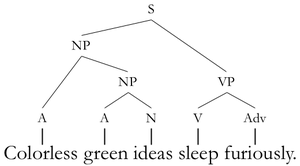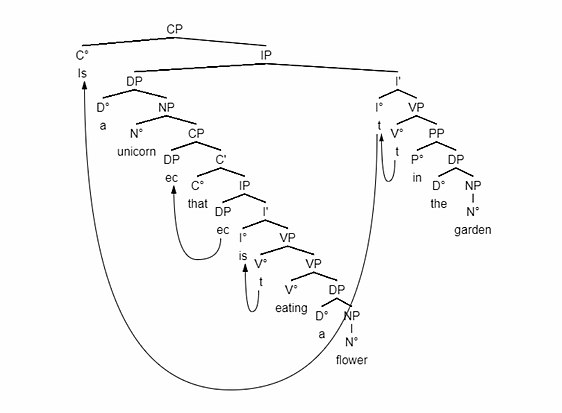Generative Grammar
Generative grammar is a theoretical approach in linguistics that regards grammar as a domain-specific system of rules that generates all and only the grammatical sentences of a given language.
In light of poverty of the stimulus arguments, grammar is regarded as being partly innate, the innate portion of the system being referred to as universal grammar. The generative approach has focused on the study of syntax while addressing other aspects of language including semantics, morphology, phonology, and psycholinguistics.

As a research tradition, generative grammar began in the late 1950s with the work of Noam Chomsky. However, its roots include earlier structuralist approaches such as glossematics. Early versions of Chomsky's approach to syntax were called transformational grammar, with subsequent variants known as the government and binding theory and the minimalist program. Recent work in generative-inspired biolinguistics has proposed that universal grammar consists solely of syntactic recursion, and that it arose recently in humans as the result of a random genetic mutation.
Frameworks
This section needs additional citations for verification. (July 2012) |
There are a number of different approaches to generative grammar. Common to all is the effort to come up with a set of rules or principles that formally defines every one of the members of the set of well-formed expressions of a natural language. The term generative grammar has been associated with at least the following schools of linguistics:
- Transformational grammar (TG)
- Standard theory (ST)
- Extended standard theory (EST)
- Revised extended standard theory (REST)
- Principles and parameters theory (P&P)
- Monostratal (or non-transformational) grammars
Historical development of models of transformational grammar
Leonard Bloomfield, an influential linguist in the American Structuralist tradition, saw the ancient Indian grammarian Pāṇini as an antecedent of structuralism. However, in Aspects of the Theory of Syntax, Chomsky writes that "even Panini's grammar can be interpreted as a fragment of such a 'generative grammar'", a view that he reiterated in an award acceptance speech delivered in India in 2001, where he claimed that "the first 'generative grammar' in something like the modern sense is Panini's grammar of Sanskrit".
Military funding to generativist research was influential to its early success in the 1960s.
Generative grammar has been under development since the mid-1950s, and has undergone many changes in the types of rules and representations that are used to predict grammaticality. In tracing the historical development of ideas within generative grammar, it is useful to refer to the various stages in the development of the theory:
Standard theory (1956–1965)
The so-called standard theory corresponds to the original model of generative grammar laid out by Chomsky in 1965.
A core aspect of standard theory is the distinction between two different representations of a sentence, called deep structure and surface structure. The two representations are linked to each other by transformational grammar.
Extended standard theory (1965–1973)
The so-called extended standard theory was formulated in the late 1960s and early 1970s. Features are:
- syntactic constraints
- generalized phrase structures (X-bar theory)
Revised extended standard theory (1973–1976)
The so-called revised extended standard theory was formulated between 1973 and 1976. It contains
- restrictions upon X-bar theory (Jackendoff (1977)).
- assumption of the complementizer position.
- Move α
Relational grammar (ca. 1975–1990)
An alternative model of syntax based on the idea that notions like subject, direct object, and indirect object play a primary role in grammar.
Government and binding/principles and parameters theory (1981–1990)
Chomsky's Lectures on Government and Binding (1981) and Barriers (1986).
Minimalist program (1990–present)
The minimalist program is a line of inquiry that hypothesizes that the human language faculty is optimal, containing only what is necessary to meet humans' physical and communicative needs, and seeks to identify the necessary properties of such a system. It was proposed by Chomsky in 1993.
Context-free grammars
Generative grammars can be described and compared with the aid of the Chomsky hierarchy (proposed by Chomsky in the 1950s). This sets out a series of types of formal grammars with increasing expressive power. Among the simplest types are the regular grammars (type 3); Chomsky argues that these are not adequate as models for human language, because of the allowance of the center-embedding of strings within strings, in all natural human languages.
At a higher level of complexity are the context-free grammars (type 2). The derivation of a sentence by such a grammar can be depicted as a derivation tree. Linguists working within generative grammar often view such trees as a primary object of study. According to this view, a sentence is not merely a string of words. Instead, adjacent words are combined into constituents, which can then be further combined with other words or constituents to create a hierarchical tree-structure.
The derivation of a simple tree-structure for the sentence "the dog ate the bone" proceeds as follows. The determiner the and noun dog combine to create the noun phrase the dog. A second noun phrase the bone is created with determiner the and noun bone. The verb ate combines with the second noun phrase, the bone, to create the verb phrase ate the bone. Finally, the first noun phrase, the dog, combines with the verb phrase, ate the bone, to complete the sentence: the dog ate the bone. The following tree diagram illustrates this derivation and the resulting structure:
Such a tree diagram is also called a phrase marker. They can be represented more conveniently in text form, (though the result is less easy to read); in this format the above sentence would be rendered as:
[S [NP [D The ] [N dog ] ] [VP [V ate ] [NP [D the ] [N bone ] ] ] ]
Chomsky has argued that phrase structure grammars are also inadequate for describing natural languages, and formulated the more complex system of transformational grammar.
Evidentiality
Some linguists such as Geoffrey Pullum have questioned the empirical basis of poverty of the stimulus arguments, which motivate the crucial generative notion of universal grammar. Linguistic studies had been made to prove that children have innate knowledge of grammar that they could not have learned. For example, it was shown that a child acquiring English knows how to differentiate between the place of the verb in main clauses from the place of the verb in relative clauses. In the experiment, children were asked to turn a declarative sentence with a relative clause into an interrogative sentence. Against the expectations of the researchers, the children did not move the verb in the relative clause to its sentence initial position, but to the main clause initial position, as is grammatical. Critics however pointed out that this was not an evidence for the poverty of the stimulus because the underlying structures that children were proved to be able to manipulate were actually highly common in children's literature and everyday language. This led to a heated debate which resulted in an increasing split between generative linguists and applied linguistics in the early 2000s.

Recent arguments have been made that the success of large language models undermine key claims of generative syntax because they are based on markedly different assumptions, including gradient probability and memorized constructions, and out-perform generative theories both in syntactic structure and in integration with cognition and neuroscience.
Generative-inspired biolinguistics has not uncovered any particular genes responsible for language. While some hopes were raised at the discovery of the FOXP2 gene, there is not enough support for the idea that it is 'the grammar gene' or that it had much to do with the relatively recent emergence of syntactical speech.
Generativists also claim that language is placed inside its own mind module and that there is no interaction between first-language processing and other types of information processing, such as mathematics. This claim is not based on research or the general scientific understanding of how the brain works.
Music
Generative grammar has been used in music theory and analysis since the 1980s. The most well-known approaches were developed by Mark Steedman as well as Fred Lerdahl and Ray Jackendoff, who formalized and extended ideas from Schenkerian analysis. More recently, such early generative approaches to music were further developed and extended by various scholars.
See also
Notes
References
Further reading
- Chomsky, Noam. 1965. Aspects of the theory of syntax. Cambridge, Massachusetts: MIT Press.
- Hurford, J. (1990) Nativist and functional explanations in language acquisition. In I. M. Roca (ed.), Logical Issues in Language Acquisition, 85–136. Foris, Dordrecht.
- Cipriani, E. (2019). Semantics in Generative Grammar. A Critical Survey. Lingvisticae Investigationes, 42, 2, pp. 134–85
- Isac, Daniela; Charles Reiss (2013). I-language: An Introduction to Linguistics as Cognitive Science, 2nd edition. Oxford University Press. ISBN 978-0-19-953420-3.
- "Mod 4 Lesson 4.2.3 Generative-Transformational Grammar Theory". www2.leeward.hawaii.edu. Archived from the original on 2018-09-16. Retrieved 2017-02-02.
- Kamalani Hurley, Pat. "Mod 4 Lesson 4.2.3 Generative-Transformational Grammar Theory". www2.leeward.hawaii.edu. Archived from the original on 2018-09-16. Retrieved 2017-02-02.
This article uses material from the Wikipedia English article Generative grammar, which is released under the Creative Commons Attribution-ShareAlike 3.0 license ("CC BY-SA 3.0"); additional terms may apply (view authors). Content is available under CC BY-SA 4.0 unless otherwise noted. Images, videos and audio are available under their respective licenses.
®Wikipedia is a registered trademark of the Wiki Foundation, Inc. Wiki English (DUHOCTRUNGQUOC.VN) is an independent company and has no affiliation with Wiki Foundation.
